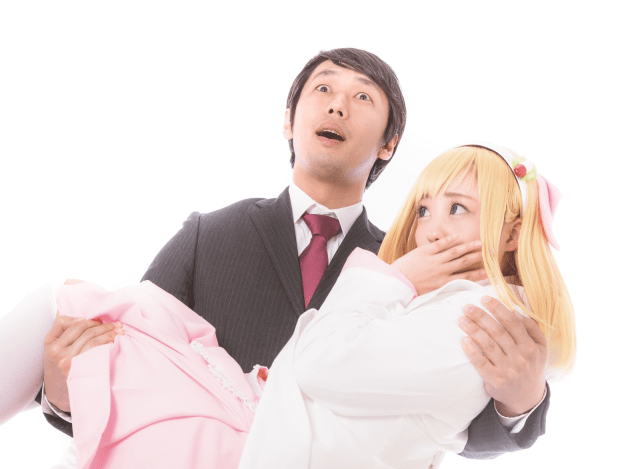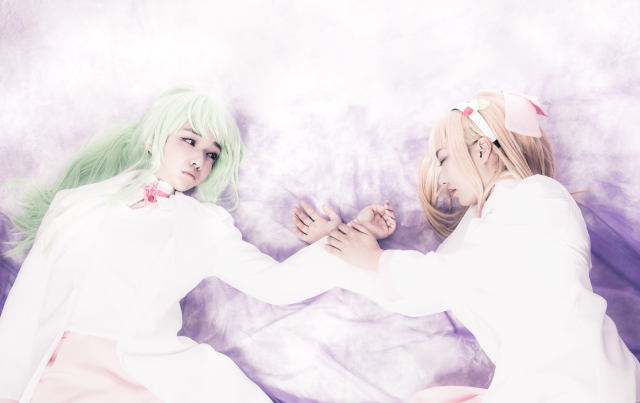
Japanese animation has long had a reputation for pushing the boundaries of what’s acceptable, but is it pushing too far these days?
Anime used to be conceived, produced, and consumed pretty much all within the confines of Japan. Sure, the occasional series would get licensed for overseas distribution, but with its story and characters so thoroughly rewritten, and its visuals so extensively re-cut, as to have little to no relation to the original version.
That started to change in the first major overseas anime boom of the 1990s, but even then, a series getting officially released outside of Japan was still the exception, not the rule. Nowadays, though, things have flipped entirely. It’s now practically a given that any anime but the most obscure or prohibitively expensive-to-license ones will stream online internationally, and most of those will get overseas home video releases too.
But as access to anime gets easier and easier, its overseas audience is continually expanding beyond people who grew up with or have an interest in/affinity for the set of Japanese societal values reflected in the medium. Because of that, there’s been increased debate as to whether or not anime needs to be more concerned with the idea of political correctness, and Japanese Twitter user @poepoeta01 recently weighed in with his opinion.
勘違いしている人が多いけど、日本の漫画やアニメが海外で人気なのは技術が凄いからだけで受けているんじゃない。
— H.N.P.P. (@mizunurechuui) February 17, 2020
他国から見て野放図なまでの表現の自由を元に、制限を受けずに作られているから面白いのだ。
「海外進出の為にポリコレを意識しないと」など的外れも甚だしい。
“Many people are under the mistaken impression that Japan’s manga and anime have earned their popularity overseas simply because of the artists’ high level of technical skill.
Japan’s manga and anime are interesting because compared to other countries, they’re made under wild, limitless freedom of expression, without any restrictions.
Saying ‘If anime isn’t more conscious about being politically correct, it won’t expand its overseas market’ it totally off the mark.”
The majority of the direct reactions to @poepoeta01’s tweet have been in support of his analysis and stance, with comments such as:
“Totally right. I think this is why Chinese-made anime-style animation hasn’t caught on internationally.”
“It’s like how late-night comedy shows are really funny, but then they lose their edge when the performers try to transition to more mainstream prime-time programs.”
“I can’t imagine another country where artists would be able to make a manga about Buddha and Jesus sharing an apartment.”
“Japanese culture has traditionally been a closed-off one, where otaku-like communities come together to push an artistic field forward, and while that inner circle is amusing itself, the art becomes so polished that eventually outsiders notice and are impressed by the quality. People who like anime support each other, and people who don’t like it don’t watch it.”
That last bit of reasoning, though, is something one could argue has new wrinkles to it in the current anime industry. With international distribution now easier than ever before, brand-new anime content is just a few clicks away for anyone with an Internet connection. Setting aside the question of whether or not anime has become more mainstream in overseas markets, access to it has definitely gotten much easier for non-Japanese media consumers, and an anime with content they find objectionable now risks leaving money on the table, money that could be used to help secure the long-term stability of a franchise and bankroll the continuing content production.
While not as numerous as the responses of agreement, @poepoeta01’s assertation that anime shouldn’t be concerned with political correctness also produced a few that disagreed.
“You’re totally wrong. I have no idea what you’re talking about.”
“Looking at the staff credits for anime, I feel like you can say that it isn’t made only by teams that are 100-percent Japanese anymore, and I think that’s going to be the case more and more.”
@poepoeta01, though, went on to offer a different idea of how the internationalization of anime could play out in a follow-up tweet, saying that he hopes Japan becomes a bastion of free expression that will welcome artists from overseas who feel like their creative efforts are being stifled by regulations in their home countries.
In a purely mathematical sense, all else equal it stands to reason that reducing the amount of potentially offensive content in an anime broadens its potential market. On the other hand, anime’s distinct style and atmosphere, which grew out of its “by Japan, for Japan” nature, has established a fanbase outside its original country of origin that’s really only surpassed by Disney in the animation field. If the goal is to maximize anime’s popularity overseas, ostensibly there’s a sweet spot between “aligns so poorly with overseas societal expectations as to anger and alienate viewers” and “overlaps so much with the tone of overseas media that it can’t stand out as unique.”
The question of whether or not Japanese anime creators want to try to find that sweet spot, or if they fell trying to do so would put too much of a damper on enthusiasm from Japanese audiences, though, is something they still seem to be sorting out.
Source: Twitter/@poepoeta01 via Hachima Kiko
Top image: Pakutaso
Insert images: Pakutaso
● Want to hear about SoraNews24’s latest articles as soon as they’re published? Follow us on Facebook and Twitter!


 Is it OK for men cosplaying as women to use the women’s restroom in Japan? Twitter debates
Is it OK for men cosplaying as women to use the women’s restroom in Japan? Twitter debates The proper response when your wife says “I can’t make dinner tonight?” Japanese Twitter debates
The proper response when your wife says “I can’t make dinner tonight?” Japanese Twitter debates Japanese university globalizes with fall start date, governor wants English as official language
Japanese university globalizes with fall start date, governor wants English as official language Japanese anime industry is earning more money than ever, almost half of it from outside Japan
Japanese anime industry is earning more money than ever, almost half of it from outside Japan Australian politician calls for immediate review of all anime due to depictions of “child abuse”
Australian politician calls for immediate review of all anime due to depictions of “child abuse” Seaside scenery, history, and so many desserts on Yokohama’s Akai Kutsu【Japan Loop Buses】
Seaside scenery, history, and so many desserts on Yokohama’s Akai Kutsu【Japan Loop Buses】 Foreigner’s request for help in Tokyo makes us sad for the state of society
Foreigner’s request for help in Tokyo makes us sad for the state of society Should you add tartar sauce to Japanese curry rice? CoCo Ichi makes diners an unusual offer
Should you add tartar sauce to Japanese curry rice? CoCo Ichi makes diners an unusual offer Ghibli Park now selling “Grilled Frogs” from food cart in Valley of Witches
Ghibli Park now selling “Grilled Frogs” from food cart in Valley of Witches Japanese city loses residents’ personal data, which was on paper being transported on a windy day
Japanese city loses residents’ personal data, which was on paper being transported on a windy day Akihabara pop-up shop sells goods made by Japanese prison inmates
Akihabara pop-up shop sells goods made by Japanese prison inmates Amazing exhibition of Japan’s legendary “cursed katana” is going on right now【Photos】
Amazing exhibition of Japan’s legendary “cursed katana” is going on right now【Photos】 Yokohama restaurant serves fried axolotl, along with giant isopod, camel, and crocodile
Yokohama restaurant serves fried axolotl, along with giant isopod, camel, and crocodile We tried Korea’s way-too-big King Tonkatsu Burger at Lotteria 【Taste Test】
We tried Korea’s way-too-big King Tonkatsu Burger at Lotteria 【Taste Test】 Larger than life Doraemon doll will delight fans, terrify pets and small children
Larger than life Doraemon doll will delight fans, terrify pets and small children McDonald’s new Happy Meals offer up cute and practical Sanrio lifestyle goods
McDonald’s new Happy Meals offer up cute and practical Sanrio lifestyle goods Japanese ramen restaurants under pressure from new yen banknotes
Japanese ramen restaurants under pressure from new yen banknotes French Fries Bread in Tokyo’s Shibuya becomes a hit on social media
French Fries Bread in Tokyo’s Shibuya becomes a hit on social media Studio Ghibli releases new action figures featuring Nausicaä of the Valley of the Wind characters
Studio Ghibli releases new action figures featuring Nausicaä of the Valley of the Wind characters Red light district sushi restaurant in Tokyo shows us just how wrong we were about it
Red light district sushi restaurant in Tokyo shows us just how wrong we were about it New private rooms on Tokaido Shinkansen change the way we travel from Tokyo to Kyoto
New private rooms on Tokaido Shinkansen change the way we travel from Tokyo to Kyoto Tokyo Tsukiji fish market site to be redeveloped with 50,000-seat stadium, hotel, shopping center
Tokyo Tsukiji fish market site to be redeveloped with 50,000-seat stadium, hotel, shopping center Beautiful Ghibli sealing wax kits let you create accessories and elegant letter decorations【Pics】
Beautiful Ghibli sealing wax kits let you create accessories and elegant letter decorations【Pics】 Studio Ghibli releases Kiki’s Delivery Service chocolate cake pouches in Japan
Studio Ghibli releases Kiki’s Delivery Service chocolate cake pouches in Japan New definition of “Japanese whiskey” goes into effect to prevent fakes from fooling overseas buyers
New definition of “Japanese whiskey” goes into effect to prevent fakes from fooling overseas buyers Our Japanese reporter visits Costco in the U.S., finds super American and very Japanese things
Our Japanese reporter visits Costco in the U.S., finds super American and very Japanese things All-you-can-drink Starbucks and amazing views part of Tokyo’s new 170 meter-high sky lounge
All-you-can-drink Starbucks and amazing views part of Tokyo’s new 170 meter-high sky lounge More foreign tourists than ever before in history visited Japan last month
More foreign tourists than ever before in history visited Japan last month New Pokémon cakes let you eat your way through Pikachu and all the Eevee evolutions
New Pokémon cakes let you eat your way through Pikachu and all the Eevee evolutions Disney princesses get official manga makeovers for Manga Princess Cafe opening in Tokyo
Disney princesses get official manga makeovers for Manga Princess Cafe opening in Tokyo Sales of Japan’s most convenient train ticket/shopping payment cards suspended indefinitely
Sales of Japan’s most convenient train ticket/shopping payment cards suspended indefinitely Sold-out Studio Ghibli desktop humidifiers are back so Totoro can help you through the dry season
Sold-out Studio Ghibli desktop humidifiers are back so Totoro can help you through the dry season Japanese government to make first change to romanization spelling rules since the 1950s
Japanese government to make first change to romanization spelling rules since the 1950s Ghibli founders Toshio Suzuki and Hayao Miyazaki contribute to Japanese whisky Totoro label design
Ghibli founders Toshio Suzuki and Hayao Miyazaki contribute to Japanese whisky Totoro label design Doraemon found buried at sea as scene from 1993 anime becomes real life【Photos】
Doraemon found buried at sea as scene from 1993 anime becomes real life【Photos】 Tokyo’s most famous Starbucks is closed
Tokyo’s most famous Starbucks is closed One Piece characters’ nationalities revealed, but fans have mixed opinions
One Piece characters’ nationalities revealed, but fans have mixed opinions We asked a Uniqlo employee what four things we should buy and their suggestions didn’t disappoint
We asked a Uniqlo employee what four things we should buy and their suggestions didn’t disappoint Princesses, fruits, and blacksmiths: Study reveals the 30 most unusual family names in Japan
Princesses, fruits, and blacksmiths: Study reveals the 30 most unusual family names in Japan Ghibli’s The Boy and the Heron won a Golden Globe. Now can it win an Oscar?
Ghibli’s The Boy and the Heron won a Golden Globe. Now can it win an Oscar? Studio Ghibli co-founder and anime director Isao Takahata passes away in Tokyo
Studio Ghibli co-founder and anime director Isao Takahata passes away in Tokyo Japanese group trying to win support for “Housewives’ Day Off” to help harried homemakers
Japanese group trying to win support for “Housewives’ Day Off” to help harried homemakers Japanese fans make landslide pick for next anime they want a Hollywood live-action adaptation of
Japanese fans make landslide pick for next anime they want a Hollywood live-action adaptation of Old Enough: Netflix show sparks global debate on parenting and child safety
Old Enough: Netflix show sparks global debate on parenting and child safety Anime Your Name to be remade as Hollywood live-action movie produced by J.J. Abrams
Anime Your Name to be remade as Hollywood live-action movie produced by J.J. Abrams Japan second-least attractive country for expats to work, survey says, but is it really that bad?
Japan second-least attractive country for expats to work, survey says, but is it really that bad? Anime artist pros draw Wonder Woman to celebrate film’s Japanese opening【Art】
Anime artist pros draw Wonder Woman to celebrate film’s Japanese opening【Art】 Your Name reportedly becomes highest worldwide earning anime film of all time
Your Name reportedly becomes highest worldwide earning anime film of all time “I’m glad I’m Japanese” posters in Kyoto spark outrage among Japanese Twitter users
“I’m glad I’m Japanese” posters in Kyoto spark outrage among Japanese Twitter users Japanese drummer makes rubber chicken cover of Attack on Titan Theme 【Interview】
Japanese drummer makes rubber chicken cover of Attack on Titan Theme 【Interview】 Tokyo University of the Arts to offer graduate program in video game design next year
Tokyo University of the Arts to offer graduate program in video game design next year What’s the highest-paying job in the anime industry?【Video】
What’s the highest-paying job in the anime industry?【Video】 Studio Ghibli’s The Boy and the Heron finally has a U.S. release date and trailer, and it’s gorgeous【Video】
Studio Ghibli’s The Boy and the Heron finally has a U.S. release date and trailer, and it’s gorgeous【Video】
Leave a Reply